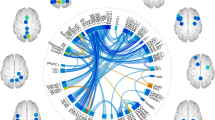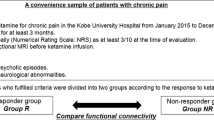Abstract
Recent work regarding the analysis of brain imaging data has focused on examining functional connectivity of the brain. In this paper, we developed and applied a novel framework to examine the modulation of functional connectivity networks during resting state or experimental stimuli. Hierarchical clustering within anatomically parcellated brain regions is used to cluster voxels into anatomically local, functionally homogenous groups. Parcellation allows for the assessment of connectivity at a region of interest level, rather than a voxel-specific level. The framework utilizes a mixed-effects model of the Fisher Z-transformed correlation between pairs of spatially distinct brain regions to assess the modulation of, or differences in, connectivity networks across multiple sessions or between groups of patients. A permutation test was employed to control family-wise type I error. We applied our method to evaluate the effects of a non-selective opioid receptor antagonist, naloxone, on resting state functional connectivity networks with multi-session multi-subject (n = 10) functional magnetic resonance imaging data. Naloxone induced a significant reduction in resting state connectivity between the right thalamus and the right parahippocampal gyrus when compared to saline solution.






Similar content being viewed by others
References
Aggleton, J., & Pearce, J. (2001). Neural systems underlying episodic memory: insights from animal research. Philosophical Transactions of the Royal Society of London. Series B, Biological Sciences, 356, 1467–1482.
Anand, A., Li, Y., Wang, Y., Wu, J., Gao, S., Bukhari, L., et al. (2005). Antidepressant effect on connectivity of the mood-regulating circuit: An fmri study. Neuropsychopharmacology, 30, 1334–1344.
Aronski, A., Kubler, A., Majda, A., & Jakubaszko, J. (1975). Comparative study of the action of naloxone (narcan) and nalorphine in man. Anaesthesia, Resuscitation and Intensive Therapy, 3, 221–230.
Baumgartner, U., Buchholz, H., Bellosovich, A., Margerl, W., Siessmeier, T., Rolke, R., et al. (2006). High opiate receptor binding potential in the human lateral pain system. NeuroImage, 30, 692–699.
Benedetti, F., Mayberg, H., Wager, T., Stohler, C., & Zubieta, J. K. (2005). Neurobiological mechanisms of the placebo effect. Journal of Neuroscience, 45, 10390–10402.
Berkowitz, B. (1976). The relationship of pharmacokinetics to pharmacological activity: Morphine, methadone and naloxone. Clinical Pharmacokinetics, 1, 219–230.
Borras, M., Becerra, L., Ploghaus, A., Gostic, J., DaSilva, A., Gonzalez, R., et al. (2004). Fmri measurement of cns responses to naloxone infusion and subsequent mild noxious thermal stimuli in healthy volunteers. Journal of Neurophysiology, 91, 2723–2733.
Braak, H., Braak, E., Yilmazer, D., & Bohl, J. (1998). Functional anatomy of human hippocampal formation and related structures. Journal of Child Neurology, 13, 146–147.
Brown, C., Russell, J., & Leng, G. (2000). Opioid modulation of magnocellular neurosecretory cell activity. Neuroscience Research, 36, 97–120.
Buchsbaum, M., Davis, G., Naber, D., & Pickar, D. (1983). Pain enhances naloxone-induced hyperalgesia in humans as assessed by somatosensory evoked potentials. Psychopharmacology, 79, 99–103.
Cordes, D., Haughton, V., Arkanakis, K., Wendt, G., & Turski, P. (2000). Mapping functionally related regions of brain with functional connectivity mri (fcmri). American Journal of Neuroradiology, 21, 1636–1644.
Cordes, D., Haughton, V., Carew, J., Arfanakis, K., & Maravilla, K. (2002). Hierarchical clustering to measure connectivity in fMRI resting-state data. Magnetic Resonance Imaging, 20, 305–317.
Doyle, G., Sheng, R., Lin, S., Press, D., Grice, D., Buono, R., et al. (2007). Identification of three mouse mu-opioid receptor (mor) gene (oprm1) splice variants containing a newly identified alternatively spliced exon. Gene, 388, 135–147.
Drolet, G., Dumont, E., Gosselin, I., Kinkead, R., Laforest, S., & Trottier, J. (2001). Role of endogenous opioid system in the regulation of the stress response. Progress in Neuropsychopharmacol Biological Psychiatry, 25, 729–741.
Floyd, N., Price, J., Ferry, A., Keay, K., & Bandler, R. (2001). Orbitomedial prefrontal cortical projections to hypothalamus in the rat. Journal of Comparative Neurology, 432, 307–328.
Fox, M., & Raichle, M. (2007). Spontaneous fluctuations in brain activity observed with functional magnetic resonance imaging. Nature Reviews Neuroscience, 8, 700–711.
Friston, K., Frith, C., Liddle, P., & Frackowiak, R. (1993). Functional connectivity: the principal component analysis of large (PET) data sets. Journal of Cerebral Blood Flow and Metabolism, 13, 5–14.
Grevert, P., & Goldstein, A. (1977). Effects of naloxone on experimentally induced ischemic pain and on mood in human subjects. Proceedings of the National Academy of Sciences of the United States of America, 74, 1291–1294.
Grevert, P., & Goldstein, A. (1978). Endorphins: naloxone fails to alter experimental pain or mood in humans. Science, 199, 1093–1095.
Haier, R., Quaid, K., & Mills, J. (1981). Naloxone alters pain perception after jogging. Psychiatry Research, 5, 231–232.
Hill, R. (1981). Endogenous opioids and pain: A review. Journal of the Royal Society of Medicine, 74, 448–450.
Jones, A., Watabe, H., Cunningham, V., & Jones, T. (2004). Cerebral decreases in opioid receptor binding in patients with central neuropathic pain measured by [11C]diprenorphine binding and pet. European Journal of Pain, 8, 479–485.
Juhasz, C., Nagy, F., Watson, C., da Silva, E., Muzik, O., Chugani, D., et al. (1999). Glucose and [11C]flumazenil positron emission tomography abnormalities of thalamic nuclei in temporal lobe epilepsy. Neurology, 53, 2037–2045.
Li, S., Biswal, B., Li, Z., Risinger, R., Rainey, C., Cho, J., et al. (2000). Cocaine administration decreases functional connectivity in human primary visual and motor cortex as detected by functional mri. Magnetic Resonance in Medicine, 43, 45–51.
Linke, R., Faber-Zuschratter, H., Seidenbecher, T., & Pape, H. (2004). Axonal connections from posterior paralaminar thalamic neurons to basomedial amygdaloid projection neurons to the lateral entorhinal cortex in rats. Brain Research Bulletin, 63, 461–469.
Ngai, S. (1976). Pharmacokinetics of naloxone in rats and in man: Basis for its potency and short duration of action. Anesthesiology, 44, 398–401.
Peltier, S., Kerssens, C., Hamann, S., Sebel, P., Byas-Smith, M., & Hu, X. (2005). Functional connectivity changes with concentration of sevoflurane anesthesia. Neuroreport, 16, 285–288.
Rencher, A. (2002). Methods of multivariate analysis (2nd ed.). New York: Wiley.
Ridley, R., Maclean, C., Young, F., & Baker, H. (2002). Learning impairments in monkeys with combined but not separate excitotoxic lesions of the anterior and mediodorsal thalamic nuclei. Brain Research, 950, 39–51.
Roberts, A., Tomic, D., Parkinson, C., Roeling, T., Cutter, D., Robbins, T., et al. (2007). Forebrain connectivity of the prefrontal cortex in the marmoset monkey (callithrix jacchus): an anterograde and retrograde tract-tracing study. Journal of Comparative Neurology, 502, 86–112.
Salvador, R., Suckling, J., Coleman, M., Pickard, J., Menon, D., & Bullmore, E. (2005). Neurophysiological architecture of functional magnetic resonance images of human brain. Cerebral Cortex, 15, 1332–1342.
Stacher, G., Abatzi, T., Schulte, F., Schneider, C., Stacher-Janotta, G., Gaupmann, G., et al. (1998). Naloxone does not alter the perception of pain induced by electrical and thermal stimulation of the skin in healthy humans. Pain, 34, 271–276.
Tibshirani, R., Walther, G., & Hastie, T. (2001). Estimating the number of clusters in a data set via the gap statistic. Journal of the Royal Statistical Society. Series B. Methodological, 63, 411–423.
Tzourio-Mazoyer, N., Landeau, B., Papathanassiou, D., Crivello, F., Etard, O., Delcroix, N., et al. (2002). Automated anatomical labeling of activations in SPM using a macroscopic anatomical parcellation of the mni mri single-subject brain. NeuroImage, 15, 273–289.
Author information
Authors and Affiliations
Corresponding author
Rights and permissions
About this article
Cite this article
Patel, R.S., Borsook, D. & Becerra, L. Modulation of Resting State Functional Connectivity of the Brain by Naloxone Infusion. Brain Imaging and Behavior 2, 11–20 (2008). https://doi.org/10.1007/s11682-007-9011-2
Received:
Accepted:
Published:
Issue Date:
DOI: https://doi.org/10.1007/s11682-007-9011-2




